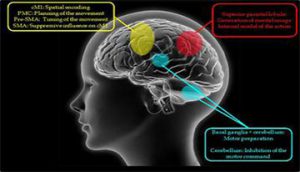Graded Motor Imagery
As discussed in other articles, chronic pain can be incredibly disabling in many ways. It leads to a reduced ability to participate in everyday life and in extremes can lead to suicide due to severe depression (Ballantyne & Sullivan 2015). Chronic pain management is therefore very important.
 It is now understood that pain is not simply the direct result of the peripheral injury. More recently, treatment for chronic pain are focused from the “top down”, brain processing perspective. The fact that the brain is plastic and can be modified by stimuli with a behavioral relevance (for example, eating or braille) is now well accepted (Florence et al 1997). Flor et al (2001) showed normalization of brain organization was correlated to a clinically important reduction of pain. Graded motor imagery (GMI) is one treatment technique from the “top down” method designed to treat chronic pain. This technique attempts to sequentially normalize central processing to remediate chronic pain (Priganc & Stralka 2001).
It is now understood that pain is not simply the direct result of the peripheral injury. More recently, treatment for chronic pain are focused from the “top down”, brain processing perspective. The fact that the brain is plastic and can be modified by stimuli with a behavioral relevance (for example, eating or braille) is now well accepted (Florence et al 1997). Flor et al (2001) showed normalization of brain organization was correlated to a clinically important reduction of pain. Graded motor imagery (GMI) is one treatment technique from the “top down” method designed to treat chronic pain. This technique attempts to sequentially normalize central processing to remediate chronic pain (Priganc & Stralka 2001).
GMI is broken down into three stages, exercising your brain in different ways. It uses brain based learning. The three different treatment techniques include left/right discrimination training, explicit motor imagery exercises and mirror therapy. These techniques are carried out in sequence.
Research shows people in pain often lose the ability to identify left or right images of body parts. Loss of laterality is known to occur in patients with Complex Regional Pain Syndrome, and Phantom Limb Pain (Reinersmann et al 2010). This study tested patients’ reaction time to identify if a limb shown to them was left or right. The reaction time was significantly delayed in both groups of patients compared to those without pain. GMI states that the ability to discriminate left and right is important for normal recovery from pain (Moseley et al 2012).
Motor imagery, requires imagined movement of the limb. These imagined movements have been demonstrated to activate areas in the brain similar to those activated in the actual execution of that movement (Decety 1996). 25 percent of the neurones in your brain are 'mirror neurones' and start firing when you think of moving or even watch someone else move.
The final stage is mirror therapy. You place your affected limb inside a mirror box and watch the reflected movements of your nonaffected limb in the mirror. This gives the illusion of a pain free, moving limb. This task activates the motor area in the brain and also provides a strong visual input to the brain that the movements are occurring normally and without pain (Matthys et al 2009).
A review of the research into GMI found a number of studies available. They found overall that a GMI program has moderate effects when compared to unordered GMI and large effects when compared to usual physiotherapy care (Bowering et al 2013).